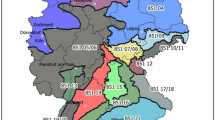Abstract
Bursaphelenchus xylophilus is a serious threat to the European conifer forests. In Turkey, four Bursaphelenchus species (B. mucronatus, B. sexdentati, B. anamurius and B. vallesianus) were isolated from wilted pine trees. To determine the effects of Bursaphelenchus species on the wilting of pine trees, a pathogenicity study was conducted comparing greenhouse and outdoor conditions. Three-year-old seedlings of Pinus nigra, P. sylvestris and P. pinaster were used for inoculation tests. Approximately 1000 (±100) nematodes of all life stages in 0.5 ml distilled water were inoculated into each seedling. The first wilting symptoms were observed in the fifth week. Mortalities occurred between the 5th and 13th weeks of the study. B. mucronatus was the most pathogenic nematode species. The most susceptible seedling species was P. pinaster, and P. nigra was the most resistant species. The mean number of wilted seedlings differed significantly among nematode species and seedling species but not between greenhouse and outdoor conditions.
Access this article
We’re sorry, something doesn't seem to be working properly.
Please try refreshing the page. If that doesn't work, please contact support so we can address the problem.
Similar content being viewed by others
References
Akbulut, S., Elekcioglu, I. H., & Keten, A. (2007a). First record of Bursaphelenchus vallesianus Braasch, Schönfeld, Polomski, and Burgermeister in Turkey. Turkish Journal of Agriculture and Forestry, 32, 273–279.
Akbulut, S., Vieira, P., Ryss, A., Valadas, V., Keten, A., & Mota, M. (2008). Bursaphelenchus Fuchs, 1937 (Nematoda: Parasitaphelenchidae) species associated with Pinus species in northern Turkey. Helminthologia, 45, 89–95.
Akbulut, S., Vieira, P., Ryss, A., Yuksel, B., Keten, A., Mota, M. M., et al. (2006). Preliminary survey of the pinewood nematode in Turkey. OEPP/EPPO Bulletin, 36, 538–542.
Akbulut, S., Yuksel, B., Serin, M., Baysal, I., & Erdem, M. (2007b). Pathogenicity of Bursaphelenchus mucronatus in pine seedlings under greenhouse conditions. Turkish Journal of Agriculture and Forestry, 31, 169–173.
Bakke, A., Anderson, R. V., & Kvamme, T. (1991). Pathogenicity of the nematodes Bursaphelenchus xylophilus and B. mucronatus to Pinus sylvestris seedlings: a greenhouse test. Scandinavian Journal of Forest Research, 6, 407–412.
Braasch, H. (1996). Pathogenitätstests mit Bursaphelenchus mucronatus an Kiefern und Fichtensämlingen in Deutschland. European Journal of Forest Pathology, 26, 205–216.
Braasch, H., Caroppo, S., Ambrogioni, L., Michalopoulos, H., Skarmoutsos, G., & Tomiczek, C. H. (1998). Pathogenicity of various Bursaphelenchus species and implications to European forests. pp. 14-22. In: K. Futai, K. Togashi, & T. Ikeda (Eds.). Sustainability of pine forests in relation to pine wilt and decline. Proceedings of the symposium, Tokyo, Japan.
Caroppo, S., Cavalli, M., Coniglio, D., & Ambrogioni, L. (2000). Pathogenicity studies with various Bursaphelenchus populations on conifer seedlings under controlled and open air conditions. Redia, LXXXIII, 61–75.
Cheng, H., Maosung, L., & Ruju, Q. (1986). A study on the morphological diagnosis and pathogenicity of Bursaphelenchus mucronatus. Journal of Nanjing Agricultural University, 2, 55–61.
Dayı, M., & Akbulut, S. (2012). Pathogenicity testing of four Bursaphelenchus species on conifer seedlings under greenhouse conditions. Forest Pathology, 42, 212–219.
EPPO, (2010). First record of Bursaphelenchus xylophilus in Glacia (Spain). EPPO Reporting Service, No. 11, 2010/202.
EPPO, (2012). New outbreak of Bursaphelenchus xylophilus in Spain. EPPO Reporting Service, No. 03, 2012/047.
Kanzaki, N., Alkawa, T., Maehara, N., & Ichihara, J. (2011). An inoculation experiment of Japanese Bursaphelenchus nematodes on Japanese black and red pine, Pinus thunbergii and P. densiflora. Journal of Forest Research, 16, 325–330.
Kanzaki, N., & Futai, K. (2006). Is Bursaphelenchus mucronatus a weak pathogen in the Japanese red pine? Nematology, 8, 485–489.
Kulinich, O., Kruglic, I. A., Eroshenko, A. S., & Kolossova, N. V. (1994). Occurrence and distribution of the nematode Bursaphelenchus mucronatus in the Russian far east. Russian Journal of Nematology, 2, 113–119.
Mamiya, Y., & Enda, N. (1979). Bursaphelenchus mucronatus n. sp. (Nematoda:Aphelenchoididae) from pinewood and its biology and pathogenicity to pine trees. Nematologica, 25, 353–365.
McNamara, D. G. (2004). Quarantine concerns about the methods used to demonstrate pathogenicity of Bursaphelenchus spp. In: M. Mota, & P. Vieira (Eds.), The pinewood nematode, Bursaphelenchus xylophilus. Proceedings of an International Workshop, (pp. 187-197; University of Evora, 2001, Portugal); Nematology Monographs and Perspectives, 1.
Mota, M. M., Futai, K., & Vieira, P. (2009). Pine wilt disease and the pinewood nematode, Bursaphelenchus xylophilus. pp. 253-274. In A. Ciancio & K. G. Mukerji (Eds.), Integrated management of fruit crops and forest nematodes. Heidelberg, Germany: Springer.
Polomski, J., & Rigling, D. (2010). Effect of watering regime on disease development in Pinus sylvestris seedlings inoculated with Bursaphelenchus vallesianus and B. mucronatus. Plant Disease, 94, 1055–1061.
Skarmoutsos, G., & Michalopoulos-Skarmoutsos, H. (2000). Pathogenicity of Bursaphelenchus sexdentati, Bursaphelenchus leoni, and Bursaphelenchus hellenicus on European pine seedlings. Forest Pathology, 30, 149–156.
Southey, J. F. (1986). Laboratory methods for work with plant and soil nematodes. London, UK: HMSO, M.A.F.F. publication.
Tarlochan, S. P., & Sutherland, J. R. (1989). Pathogenicity of Canadian isolates of the Bursaphelenchus xylophilus (pinewood nematode) to provenances of Pinus sylvestris and Pinus contorta as grown in Finland: A greenhouse study. Scandinavian Journal of Forest Research, 4, 549–557.
Tomminen, J. (1993). Pathogenicity with Bursaphelenchus mucronatus in Scots pine in Finland. European Journal of Forest Pathology, 23, 236–243.
Wingfield, M. J., Bedker, P. J., & Blanchette, R. A. (1986). Pathogenicity of Bursaphelenchus xylophilus on pines in Minnesota and Wisconsin. Journal of Nematology, 18, 44–49.
Acknowledgments
This research was supported by the Scientific and Technological Research Council of Turkey (TUBITAK, Project No. 107O088). The authors thank Dr. W. Terrell Stamps (University of Missouri–Columbia, USA) for his help with statistical analysis. We also thank the General Forestry Directorate of Turkey for field support.
Author information
Authors and Affiliations
Corresponding author
Rights and permissions
About this article
Cite this article
Akbulut, S., Yüksel, B., Serin, M. et al. Comparison of pathogenic potential of Bursaphelenchus species on conifer seedlings between greenhouse and outdoor conditions. Phytoparasitica 43, 209–214 (2015). https://doi.org/10.1007/s12600-014-0433-2
Received:
Accepted:
Published:
Issue Date:
DOI: https://doi.org/10.1007/s12600-014-0433-2




